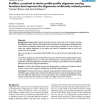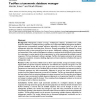820 search results - page 20 / 164 » Using Multiple Alignments to Improve Gene Prediction |
BMCBI
2007
13 years 7 months ago
2007
Background: The structure annotation of a genome is based either on ab initio methodologies or on similaritiy searches versus molecules that have been already annotated. Ab initio...
BMCBI
2006
13 years 7 months ago
2006
Background: Multiple sequence alignment is the foundation of many important applications in bioinformatics that aim at detecting functionally important regions, predicting protein...
BMCBI
2005
13 years 7 months ago
2005
Background: Profile-profile methods have been used for some years now to detect and align homologous proteins. The best such methods use information from the background distributi...
BMCBI
2008
13 years 7 months ago
2008
Background: While the C. elegans genome is extensively annotated, relatively little information is available for other Caenorhabditis species. The nematode genome annotation asses...
BMCBI
2006
13 years 7 months ago
2006
Background: Phylogenetic analysis of large, multiple-gene datasets, assembled from public sequence databases, is rapidly becoming a popular way to approach difficult phylogenetic ...


